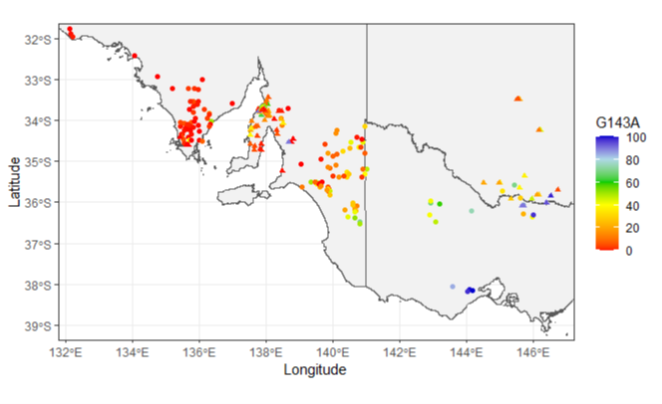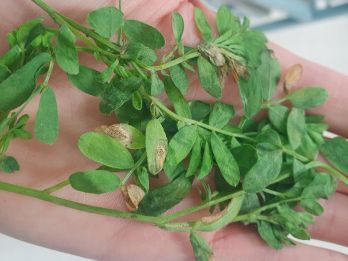Crop Watch 14 July 2023

Monitor lentils for ascochyta blight
Growers are urged to monitor lentil crops closely for ascochyta blight (AB) early this season. Reports have been received of AB on PBA Hallmark XT, PBA Hurricane XT and GIA Lightning lentil crops on the Yorke Peninsula and as far north as Port Germein. Severe disease on volunteer lentils has also been observed on the Adelaide Plains and Yorke Peninsula.
Pathotype 2 AB isolates that are virulent on PBA Hallmark XT, PBA Hurricane XT and GIA Lightning, among others, are dominant in the South Australian pathogen population. However, new genetic variants with combined pathotype 1 (Nipper-virulent) and pathotype 2 (Hurricane-virulent) virulence are also present. Isolate testing is ongoing, however in SA isolates with dual virulence may be being selected for over time in farming systems where lentils are cropped intensively and under close rotation.
Management advice
AB is driven by rainfall, and disease will spread and become more severe with each rain event. The pathogen can be harboured on seed and stubble as well as infected volunteer lentils. Expect a 10 to 14 day latent period between infection after a rain event and symptom development.
If in-crop seedlings are showing moderate to high levels of disease, a fungicide spray timed ahead of rain events may be required.
AB disease will not spread during dry periods and fungicides can be held off while there is no rain.
It is recommended that lentil crops are closely monitored during the season for any signs of disease. Growers are encouraged to review the current NVT disease ratings of AB pathotype 1 and pathotype 2 of lentil and manage disease according to the worst (more susceptible) rating.
Early start for cereal stubble borne diseases
SARDI Cereal Pathology Group has received multiple reports of stubble borne diseases in:
- Wheat
- Powdery mildew
- Septoria tritici blotch (STB)
- Barley
- Net form net blotch (NFNB)
- Spot form net blotch (SFNB)
The 2022 growing season left high inoculum loads of these diseases on stubble and wet winter conditions this season have enabled early infection.
Growers are encouraged to inspect wheat and barley crops for signs of early disease and prepare in-season management strategies such as fungicide applications. Varieties rated susceptible to very susceptible are at highest risk of continued disease development and subsequent yield loss. Ratings for these diseases in commonly grown South Australian varieties are listed in the tables below. A comprehensive list of ratings can be accessed through the NVT website.
Barley NVT disease resistance ratings
| Variety | Net form net blotch | Spot form net blotch |
|---|---|---|
| Alestar | MR-S | S |
| Banks | MR | S |
| Beast | MR-S | MS |
| Bottler | R-MS | MSS |
| Combat | MR-MSS | RMR |
| Commander | S-VS | MSS |
| Commodus CL | MR-MSS | MSS |
| Compass | MRMS-S | MS |
| Cyclops | MR-MS | MS |
| Fathom | MSS-SVS | RMR |
| Laperouse | MR-MS | MRMS |
| Leabrook | MR-MSS | MS |
| Maximus CL | MR-MS | MS |
| Minotaur | MR-MS | S |
| RGT Planet | MRMS-SVS | SVS |
| Rosalind | R-MRMS | S |
| Spartacus CL | MS-VS | S |
| Titan AX | MRMS-MSS | MS |
| Zena CL | MR-MSS | S |
Wheat NVT disease resistance ratings
| Variety | Powdery mildew | Septoria tritici blotch |
|---|---|---|
| Ballista | SVS | SVS |
| Brumby | R/S | S |
| Calibre | S | S |
| Catapult | S | MSS |
| Chief CL Plus | SVS | S |
| Cutlass | MSS | MSS |
| Denison | S | MSS |
| Emu Rock | MSS | S |
| Grenade CL Plus | MSS | S |
| Longsword | S | MS |
| LRPB Anvil CL Plus | VS | VS |
| LRPB Trojan | S | S |
| Mace | MSS | SVS |
| Razor CL Plus | S | SVS |
| RockStar | SVS | S |
| Scepter | SVS | S |
| Sheriff CL Plus | SVS | S |
| Valiant CL Plus | VS | MSS |
| Vixen | SVS | S |
Fungicide resistance and applications
Fungicide applications for NFNB, SFNB, powdery mildew and STB should be targeted at growth stages GS31 and GS39 for effective disease control. Fungicide resistances are prevalent in South Australia and should be considered when developing spray strategies. To help reduce the risk of fungicide resistance development it is best practice to rotate and mix fungicide modes of action (MoA) and never apply the same fungicide twice in a row.
The Australian Fungicide Resistance Extension Network lists resistance status for actives within each MoA group along with other information on fungicide resistance management. Farm-level or regional field performance may vary from that recorded here.
Barley – Fungicide group resistance and reduced sensitivity status in SA
| Pathogen | Group 3 (DMI) | Group 7 (SDHI) | Group 11 (QoI) |
|---|---|---|---|
| Barley powdery mildew | Active | Active | Active |
| Net form of net blotch | Some active compounds compromised | Resistance present | Active |
| Spot form of net blotch | Active | Active | Active |
| Barley scald | Active | Active | Active |
| Barley leaf rust | Active | Active | Active |
| Ramularia leaf spot | Active | Active | Not registered for this pathogen |
Wheat – Fungicide group resistance and reduced sensitivity status in SA
| Pathogen | Group 3 (DMI) | Group 7 (SDHI) | Group 11 (QoI) |
|---|---|---|---|
| Wheat powdery mildew | Some active compounds compromised | Active | Resistance present |
| Septoria tritici blotch | Some active compounds compromised | Active | Active – single isolate detected in the lower SE, no further isolates detected |
| Septoria nodorum blotch | Active | Active | Active |
| Leaf rust | Active | Active | Active |
| Stripe rust | Active | Active | Active |
| Stem rust | Active | Active | Active |
| Tan spot (yellow spot) | Active | Active | Active |
| Eyespot | Active | Active | Not registered for this pathogen |
Wheat powdery mildew focus
Wheat powdery mildew has resistance to QoI strobilurins (group 11 fungicide) and reduced sensitivity to DMIs (group 3 fungicide) through genetic mutations. The distribution and frequency of these mutations vary across South Australia. Trengove Consulting, the Department of Primary Industries, NSW and Curtin Universities’ Centre for Crop and Disease Management Fungicide Resistance Group have conducted surveys of wheat paddocks from 2020 to 2022 to track the prevalence of the mutations. The DMI mutations are broadly prevalent across the state, while the QoI mutation varies between and within regions.

Frequency (%) of G143A mutation, conferring resistance to QoI (strobilurin, group 11) fungicides, from 220 commercial paddocks sampled in 2020, 2021 and 2022 (Sam Trengove, Trengove Consulting, Steven Simpfendorfer NSWDPI and CCDM Fungicide Resistance Group)
This season, avoid applying group 11 fungicides on wheat in locations where the mutation has been recorded at a high frequency (blue, green or yellow map markers).
Emergency permits have been granted for 3 chemistries in fungicide groups 13 and U8, to provide alternative modes of action for powdery mildew control with shifts in fungicide sensitivity and resistance in groups 3 and 11 – see Industry Pesticide Permits.
For more information, see Fungicide resistant wheat powdery mildew – update on management and resistance testing.
Send us your pulse, canola and cereal crop disease samples
SARDI is seeking diseased samples from this year’s commercial pulse, canola, barley and oat crops. The samples will assist research scientists Sara Blake and Tara Garrard with monitoring the nature and extent of disease in 2023.
Grain growers and advisers are being asked to help by providing samples of:
- ascochyta blight in lentil, faba bean and chickpea
- sclerotinia in pulse and canola crops
- net form net blotch and scald in barley
- Septoria in oats.
These samples will contribute to research into :
- changes in disease resistance of current varieties
- pathogen population changes including pathotyping
- investigating how serious a disease sclerotinia is for the southern pulse industry
For ascochyta and sclerotinia in pulses and canola, collection kits with return envelopes will be provided to growers and advisers willing to provide samples, please contact:
Sara Blake
Phone: (08) 8429 2248
Email: sara.blake@sa.gov.au
For net form net blotch and scald in barley, and septoria in oats, please contact:
Tara Garrard
Phone: (08) 8429 2247
Email: tara.garrard@sa.gov.au
Stay up to date with the latest disease-related issues and solutions for broadacre crops during the growing season.





